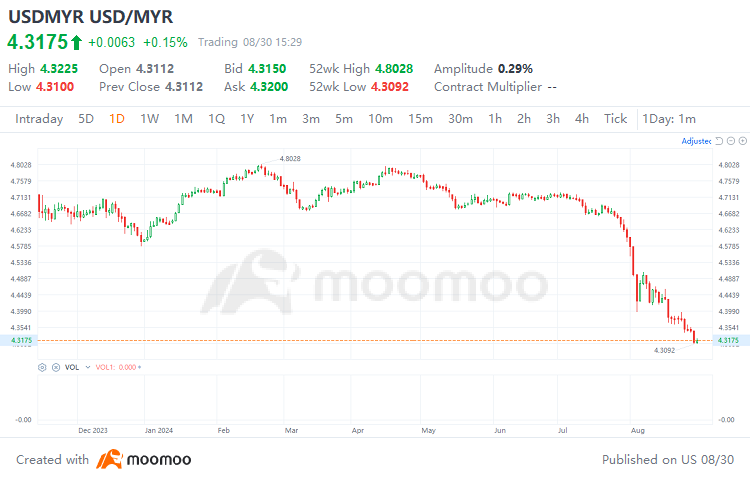Rising Ringgit and U.S. Rate Cut: Buy U.S. Stock Now?
As the prospect of a Federal Reserve rate cut looms, volatility in global financial markets has escalated, leading to a significant dip in the $USD (USDindex.FX)$ U.S. Dollar Index. This shift has stirred the global currency markets and unveiled unique investment opportunities for Malaysian investors. At the same time, this increased volatility in the U.S. stock market poses challenges and opens potential avenues for astute investors.

Firstly, we need to consider the effects of exchange rate fluctuations on Malaysian investors. The U.S. dollar has recently depreciated by approximately 8% against the Malaysian ringgit, enhancing the purchasing power of Malaysian investors when converting their currency into dollars. However, these fluctuations also carry risks, as any reversal in exchange rates could diminish investment returns. Consequently, investors eyeing U.S. stocks should remain vigilant about these fluctuations. For long-term investors who do not intend to convert their dollars back to ringgit shortly, the ongoing depreciation of the dollar may be less concerning.
Next, we address the implications of U.S. interest rate cuts on the stock market. Generally, rate cuts lower borrowing costs, stimulate economic growth, and positively influence the stock market. Nonetheless, they can also spark concerns about future economic conditions, leading to short-term market volatility. In such environments, it is crucial for investors to judiciously select their investment targets to secure robust returns throughout the rate-cut cycle.
Historically, stocks typically rally after an initial rate cut, consolidate over the first three months, and then continue an upward trajectory, assuming there is no economic recession. In non-recession scenarios, equities usually perform well six to twelve months post-rate cut. However, when rate cuts are a response to economic downturns or market turmoil, market performance can be less favorable. For example, during the recession-triggered rate cuts of 2001 and 2007, nearly all sectors within the S&P 500 index faced declines.

Historically, defensive sectors have outperformed cyclical ones in the three to six months following a rate cut. In the early stages of a rate-cut cycle, amidst macroeconomic uncertainties, investors often gravitate towards defensive stocks to mitigate potential recession risks. Sectors like Consumer Staples, Health Care, and Utilities have consistently shown robust performance during these periods, while cyclical sectors such as Consumer Discretionary, Energy, and Materials typically lag.
Assets like $iShares 20+ Year Treasury Bond ETF (TLT.US)$, $Direxion Daily 20+ Year Treasury Bull 3X Shares ETF (TMF.US)$, and $iShares 7-10 Year Treasury Bond ETF (IEF.US)$ tend to thrive during rate reduction cycles. These assets, with their long durations, are highly sensitive to interest rate changes. A rate cut by the Federal Reserve generally reduces the yield on newly issued bonds, making existing bonds more attractive and driving up their prices. Investors benefit from both fixed interest income and the appreciation in bond prices. However, it is important to note that dividends from these assets may be taxable in Malaysia, potentially reducing net investment returns. Moreover, U.S. Treasury assets can experience significant volatility during market shifts, and investors should assess their risk tolerance when allocating investments.

Index funds like $SPDR S&P 500 ETF (SPY.US)$ and $Invesco QQQ Trust (QQQ.US)$ provide an efficient and cost-effective way to invest in the broader market or specific sectors. Lower interest rates typically boost economic activity and can enhance stock market gains, which index funds can capitalize on. However, the performance of index funds closely mirrors overall market performance and thus is vulnerable to market volatility. When choosing index funds, investors should consider factors like expense ratios, tracking errors, and the general market climate. Additionally, a deeper understanding of market trends and macroeconomic conditions is crucial for making informed decisions during market fluctuations.
For companies burdened with high debt yet exhibiting strong business performance, a reduction in interest rates could offer significant benefits. Lower interest rates can decrease borrowing costs, allowing such companies to issue new debt to replace older, higher-rate debt, thus reducing financial expenses. As their financial health improves, their profits may increase, which could subsequently boost their stock prices. However, the recovery of these companies may be gradual and influenced by various factors.
When investing in such companies, investors should diligently monitor financial statements, particularly focusing on debt structure and interest expenses. It is also crucial to consider the company's business model, competitive position in the market, and industry outlook. Through a thorough analysis of these elements, investors can better assess the investment potential of these companies in a low-interest-rate environment.
Notable examples of such companies include $Royal Caribbean (RCL.US)$ and $Carnival (CCL.US)$ . These firms are known for their robust business models and strong brand influence, which position them favorably for capitalizing on favorable financial conditions and market opportunities.
Join to learn more investment knowledge>>
Join to learn more investment knowledge>>

Disclaimer: Moomoo Technologies Inc. is providing this content for information and educational use only.
Read more
Comment
Sign in to post a comment
